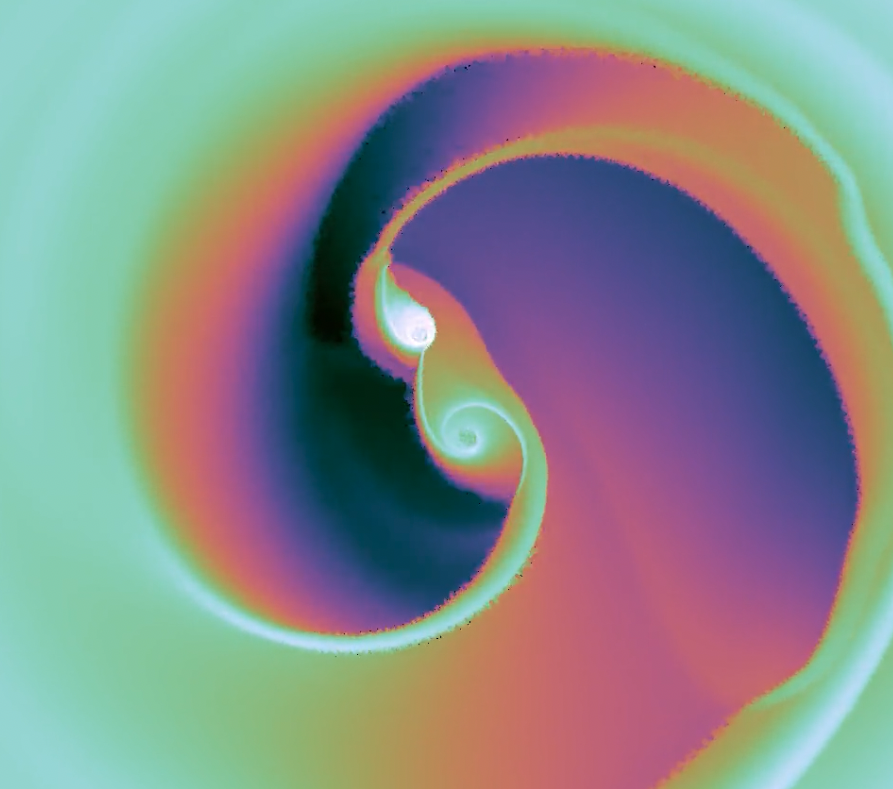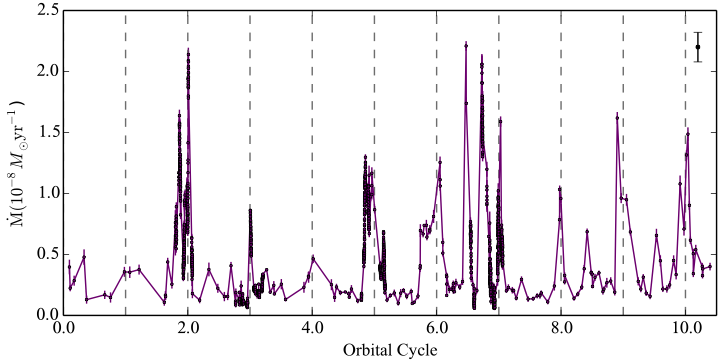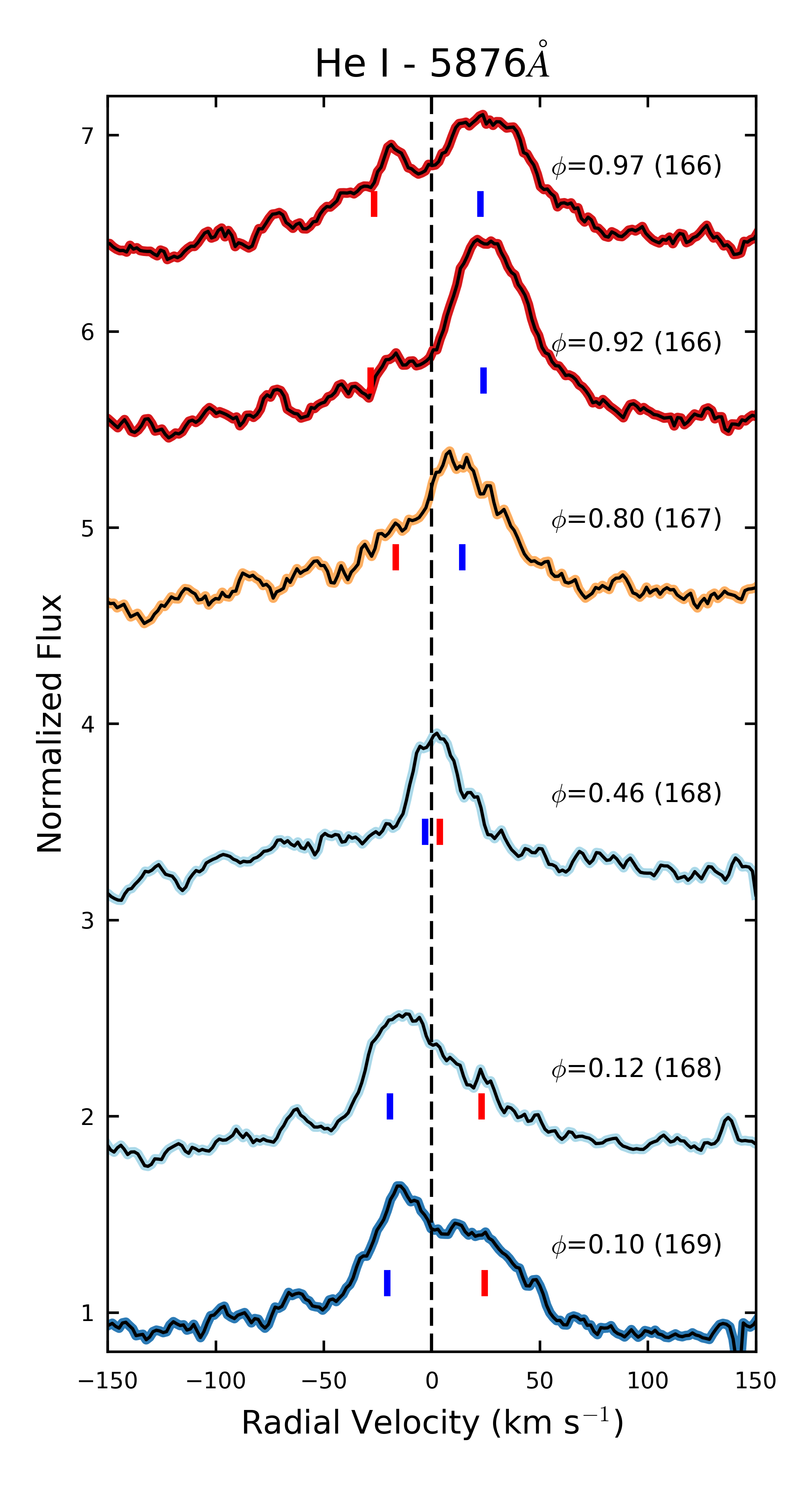Accretion in Short-Period Binary Systems
(A more general overview of my research program can be found here.)
Dissertation Overview
This research thread was the main focus of my thesis. I investigated the interaction between young binary star systems and their circumbinary disks
Background
Over the past thirty years, a detailed picture of star formation has emerged that highlights the significance of the interaction between a pre-main sequence (pre-MS) star and its protoplanetary disk. Many properties of the emergent star, the lifetime of the circumstellar disk, and the formation of planets are, in part, determined by this star-disk interaction.
Many stars, however, form with companions that have the ability to alter the distribution of disk material and the dynamics of accretion flows. Stellar companions fundamentally change the single-star-disk interaction and its implications for the evolution of the star-disk system.
 Numerical simulations of the binary-disk interaction predict that in short-period systems, orbital resonances will dynamically clear a central region of the protoplanetary disk, leaving open the possibility for three stable accretion disks: a circumstellar disk around each star and an encompassing circumbinary disk. Although orbital resonances prevent stable orbits near the binary, accretion is predicted to proceed in periodic accretion streams that form at the inner edge of the circumbinary disk, cross the dynamically cleared gap, and feed circumstellar disks or accrete directly onto the stars themselves. This pulsed-accretion paradigm predicts bursts of accretion that are periodic with the orbital period, where the duration, amplitude, location in orbital phase, and which star is preferentially fed, all depend on the orbital parameters (eccentricity, mass ratio, semi-major axis, etc). Many of these predictions, especially those regarding temporal variations in the accretion rate, remain largely untested.
Numerical simulations of the binary-disk interaction predict that in short-period systems, orbital resonances will dynamically clear a central region of the protoplanetary disk, leaving open the possibility for three stable accretion disks: a circumstellar disk around each star and an encompassing circumbinary disk. Although orbital resonances prevent stable orbits near the binary, accretion is predicted to proceed in periodic accretion streams that form at the inner edge of the circumbinary disk, cross the dynamically cleared gap, and feed circumstellar disks or accrete directly onto the stars themselves. This pulsed-accretion paradigm predicts bursts of accretion that are periodic with the orbital period, where the duration, amplitude, location in orbital phase, and which star is preferentially fed, all depend on the orbital parameters (eccentricity, mass ratio, semi-major axis, etc). Many of these predictions, especially those regarding temporal variations in the accretion rate, remain largely untested.
Characterizing of the Binary-Disk Interaction
To test the predictions of binary accretion theory, we have compiled a sample of nine short-period, pre-main sequence binaries for an intensive observational study.
 With time-series optical and near-infrared photometry, we measure the stellar accretion rate and search variations in the relative amount and temperature of circumstellar material, all as a function of orbital phase. The diverse orbital parameters of the binaries in our sample allow for a general test of the binary-disk interaction, placing constraints on the orbital-parameter dependence of certain predictions. More on this part of my dissertation and the detection of pulsed accretion events can be found at the link below.
With time-series optical and near-infrared photometry, we measure the stellar accretion rate and search variations in the relative amount and temperature of circumstellar material, all as a function of orbital phase. The diverse orbital parameters of the binaries in our sample allow for a general test of the binary-disk interaction, placing constraints on the orbital-parameter dependence of certain predictions. More on this part of my dissertation and the detection of pulsed accretion events can be found at the link below.
Time-Series Photometry of Accreting Pre-MS Binary Stars
For a subset of our binaries, we have also obtained time-series, high-resolution, optical spectra with the SALT High-Resolution Spectrograph (HRS). With these data, we search for coherent velocity structures in orbital phase that trace accretion streams and use narrow accretion tracers to determine which star within the binary is preferentially fed. A detailed description of our spectroscopic analysis can be found at the following link.
Time-Series Spectroscopy of Accreting Pre-MS Binary Stars
The results of our photometric monitoring campaign have provided strong evidence for periodic pulsed accretion events in pre-MS binaries, just as models predict. However, there are notable differences in the duration and location in orbital phase between the models and our observations. To root out the cause of these differences, we are in the process of creating hydrodynamic simulations of binary accretion tailored to a subset of our binaries. More on this project can be found at the following link.
Hydrodynamic Simulations of Binary Accretion
(This work would not be possible without the following people: Robert Mathieu, Greg Herczeg, David Ardila, Christopher Johns-Krull, Rachel Akeson, David Ciardi, Lisa Prato, and Diego Munoz)

